Development History
During the development of CGAA the differences between normal
software development and game development became very apparent to
me, so the development was a huge learning experience.
This lead to me spending a lot of time on experimenting in and
researching certain areas of the game, even if they would not all
be visible to the player.
The following is a recounting of what I did in these areas and
more importantly what I learned there.
In other words:
The top 6 development time-sinks that might not be obvious from
playing CGAA.
Table of Contents
- 1. Frameworks versus Engines
- 2. Shapes, Graphics and Collision
- 3. Performance Optimization
- 4. AI: From FSM to Linked Lists
- 5. Functional JavaScript to Object Oriented TypeScript
- 6. UI: Modes to Clicks
1. Frameworks versus Engines
From the beginning of development, the concept of CGAA included a
short playtime and a low barrier to entry. For this reason, it made
sense to make it a browser game, because in this way everyone could
play it. Phaser is one of the most used and well known frameworks to
develop browser games with, so it was the natural choice.
I wanted to use a framework and not an engine, because my goal was
to spend most of my development time programming and not searching
for options in an editor. A framework mostly tries to deliver
buildings block while also giving structural guidance how the
resulting software should be architected. An engine is more high
level, as it usually includes editors and further developer tooling
as well as a generally unified developer experience for game
creation.
CGAA being my first real game, the proportions of the qualitative
difference between frameworks and engines was unclear to me at the
beginning of the development. Before choosing Phaser I made sure
that it had examples, that there was documentation and that the
community was still alive if I had questions. However, during
development I discovered that besides the building blocks for games,
Phaser really mostly offered loose suggestions how to structure your
games (use scenes, use game objects etc.) and I had the feeling that
I spent a lot of time re-inventing the wheel instead of building
another bicycle.
In the end I think Phaser is a mixed bag for first time game
developers. It provides all the necessary building blocks, but upon
intensive inspection the documentation is incomplete, there are no
complex examples and without knowledge of game programming patterns,
I was going in circles a lot of the time when it came to structuring
the source code which lead to a lot of time spent refactoring.
2. Shapes, Graphics and Collision
In CGAA the most important shape is the circle. For this and other basics shapes like the rectangle, Phaser offers an API. Because the design of CGAA is minimal, it was natural to try to generate all graphics in-game. The workflow for this is to first draw a shape, then capture it and save it as a texture and then add the animation frames to the texture.

In the case of a circle texture, the frame-step would look like this:
this.scene.textures.list[this.title].add(1, 0, 0, 0, 2 * this.radius, 2 * this.radius);
this.scene.textures.list[this.title].add(2, 0, 2 * this.radius, 0, 2 * this.radius, 2 * this.radius);
This approach was very convenient, because it mostly avoided needing
to ship additional assets, input-output problems from graphic
programs or pixel errors. The hard part was finding the correct APIs
and hardcoding the basic measurements for the shapes without an
immediate visual feedback.
This worked fine for basic shapes and even for more complicated
combined shapes like the chain-weapon I found a solution by reusing
the polygon shapes that I implemented for collision detection.
For collision and overlap detection I used the most performant and
simplest physics engine of Phaser: Arcade. The design of the game
did not demand more complex physical operation, so this choice was
obvious.
However, the drawbacks where that only circles and rectangles were
supported by Arcade and the chain-weapon consisted of a more complex
shape: the arrow. To allow for this kind of collision detection I
implemented polygon shapes and a separate collision detection
system, that would only be activated when a unit was attacking and
then would synchronize the textures position (e.g. the weapon) with
the corresponding polygon shape to calculate if a collision happened
(in hindsight it might be more performant to approximate all the
parts of the weapon separately with basic circles and rectangles).
For the polygon based collision I tried out many different libraries
(e.g. that used the Separating Axis Theorem) and due to huge
differences in how the coordinates are interpreted, I settled for
the one library that was compatible and wrote missing cases (e.g.
collision of circle with circle) myself.
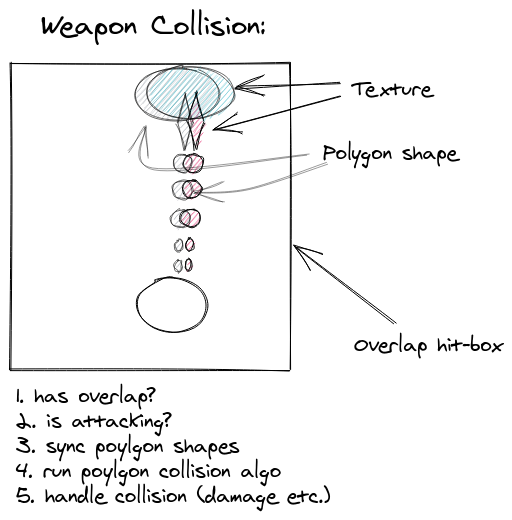
As the development progressed it became more and more tedious to
hand-adjust the measurements of the shapes and complex shapes like
the chain-weapon took nearly a week of full-time work to get right,
including the animations (this also had to do with Phasers weird
interpretation of angles).
It also became clear that trying to enhance the graphics (e.g.
rounding the edges of towers to make them more distinct from walls)
would not be feasible with this approach.
At the end of the development I came to the conclusion that a more
classical approach (e.g. using an extra graphics program) might have
been better suited or a hybrid approach where the generation of
graphics is a pre-processing step which allows to hand-adjust fine
details.
3. Performance Optimization
Webpages are very performance sensitive, because the platform is
inherently restricting how many resources can be used. This means,
that to implement even a comparatively simple game computation needs
to be minimized.
Early in development I already ran into bottlenecks when it came to
physics calculation. Analyzing the performance in the Chrome
Developer Tools, one of the culprits turned out to be my line of
sight mechanic, where the enemies can spot the player and other
units if they are to close and attack them. The towers also had a
line of sight mechanic but implementing these two different physics
hitbox/area types lead to a huge drop in the framerate.
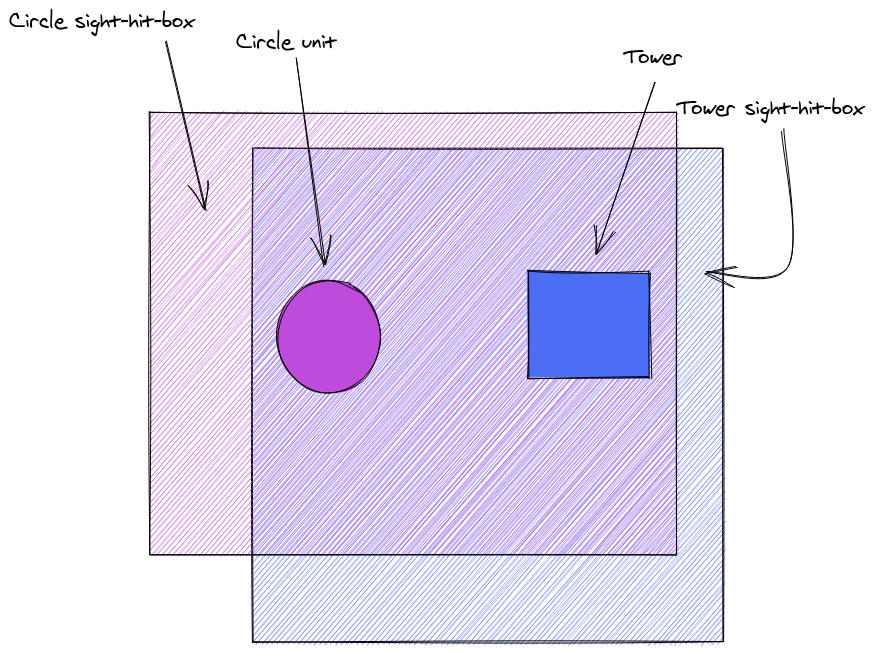
The solution was to use just one line of sight area in the moving units and to implement the tower line of sight in the loop that gets executed when other units are entering the area.
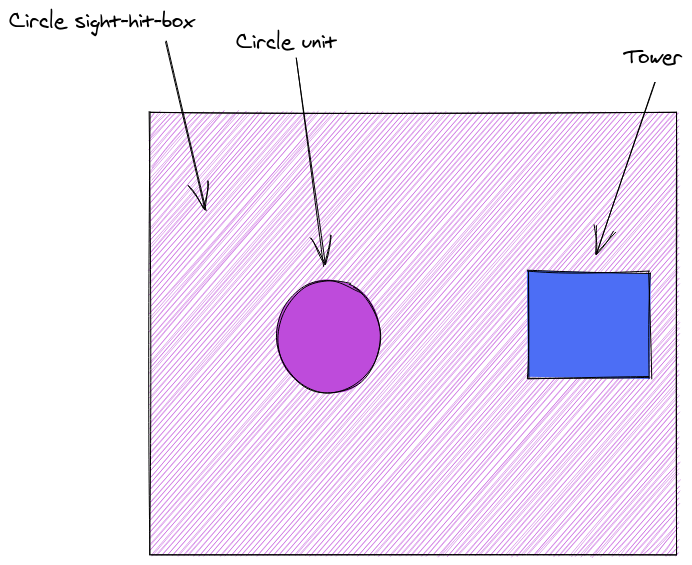
With this at least one third of line of sight areas could be reduced. This improvement and many other smaller improvements (e.g. using arrays and sets instead of objects where possible, optimizing access and other types of algorithms in physics heavy hot paths), the framerate was stable in normal situations.
However, at certain points in the game, when new towers were build or new units spawned, I again noticed pretty severe framerate drops. This was the case because I was creating new objects and because of the way the JavaScript heap works, this lead to increased computation. I could solve this by using a concept from Game Programming Patterns, the Object Pool, where I created all the objects that I needed for the game at the start and held them in standby and then just reused the same objects again and again.

For this I need to implement my own Object Pools as the interface for the Phaser Object Pools were not suited to my already written code. After fine tuning the amount of objects to create in the beginning and generally reducing the amount of objects/units used, I finally achieved a reasonable performance in every game state. Further improvement would probably require a new implementation of my collision detection.
4. AI: From FSM to Linked Lists
When it comes to game AI a Finite State Machine is often used to implement complicated behavior. In the case of CGAA this also was my first choice. However, after a while it became apparent that my informal approach to FSM (states include informal sideffects that can impact other states) lead to a few critical bugs (e.g. units running into walls leading to huge drops in framerate) and the complexity of my bug fixes became to much for my simple use case. So I could have re-implemented my FSM with a FSM framework to formalize all the cases or find a simpler solution.
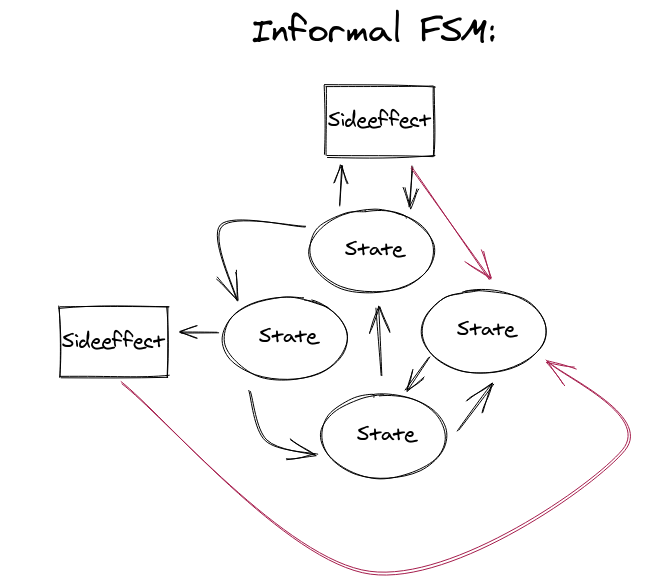
I choose to re-think my AI and implement a simple system based on a kind of Linked List.
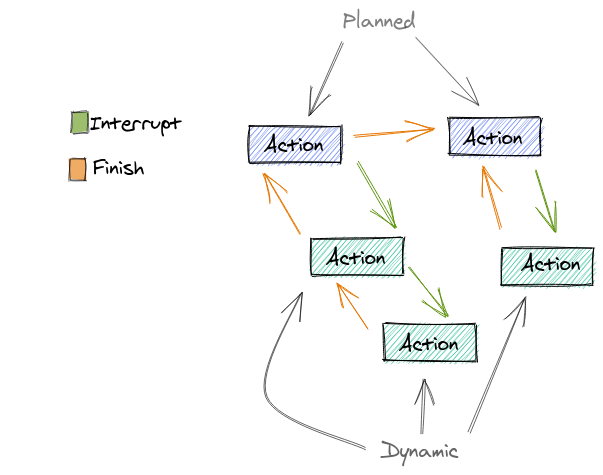
Inspired by
Naughty Dogs list-based Action-System, I abstracted my AI as an array of planned actions that a unit
wants to fulfill.
If one action is complete, it alerts the array holder and the next
planned action is started.
If the unit is interrupted during an action (e.g. the player is in
attack range or the wave unit gets attacked before it reaches its
destination), the action is made into a kind of linked list. A new
dynamic action is created that deals with the interruption. This new
action is linked to the interrupted action and is the new first
entry in the “linked list” and once the new action is finished it
notifies the old action and makes that action the first entry in the
list again.
5. Functional JavaScript to Object Oriented TypeScript
When starting the development, I envisioned the randomized game map
as a computation problem that would be suited to a functional
approach. It went through different phases that could be modeled as
semi-pure functions that used the input of the respective previous
functions.
A simplified example:
- f() = Calculate middle points of Camps
- g() = Calculate wall positions of Camps
- h() = Calculate randomized building positions
By composing these functions I could then generate the Game Map.
However, it became clear that partial or intermediate values from
this composition where needed for other purposes. For example the
exits of Camps, which are used to determine where not to place
walls, where needed for path calculation and placing of the diplomat
circles.
Including these values in the outputs of the functions lead to huge
Map Objects being passed around.
When it became apparent that a few of the results would need to be
accessed and changed by the Game Units (e.g. modifying the
0-1-representation of the Game Map), I converted most of the
functions to objects and the results and partial results to fields
on those objects.

I also converted the code base to Typescript as the amount of
implicit types of objects was steadily growing and needed to be
managed somehow.
Making all the needed data available could have been achieved with a
functional style, e.g. by decomposing the code into smaller
functions.
However, when looking at a minimal definition of object-orientation
(objects are fields and procedures, programs are interacting
objects) it became clear that this approach most closely mapped to my
mental model of a real-time game (interacting units with changing
state) and that is why I decided to shift my strategy.
In the end only the parts of the games computation remained functional, where it was easy to see that there was no dynamic change necessary. For example the initial programmatic generation of all textures or the creation of the animation frames.
6. UI: Modes to Clicks
3D games often switch between different modes of interaction via
button press. For example drawing a weapon in an RPG means switching
to attack mode and then switching between weapons.
One of the influences for CGAA was "Orcs Must Die!" where
the player can switch between Towers or Traps by using different
keyboard buttons. Naturally the first controls for CGAA followed
this schema.
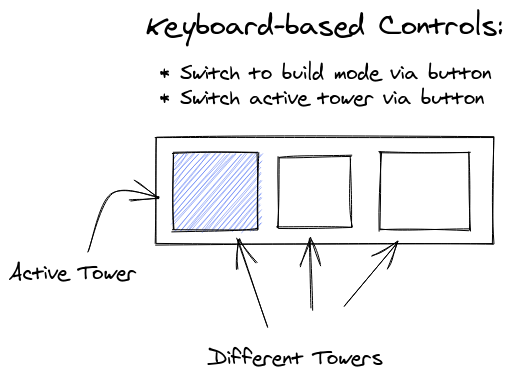
After play-testing this with different groups of players (people
with gaming experience to non-gamers), it was obvious that this was
not going to work. While for me the different modes were obvious and
I was able to use them to build towers very fast and interact with
the diplomats, for my playtesters this was just confusing and most
of them even did not figure out that you could interact with the
diplomats at all.
During my research I found out that Computer Scientists like
Larry Tesler
already argued against using Modes in User Interfaces in the
seventies because of the
known harmful effects
they can have. Tesler, who co-invented the modern understanding of
copy-paste, argued that Click-based UI was the better alternative.
When looking at mode based tools like vim, it seems that Modes might
be appropriate mostly in systems that are used by experts and my
game was certainly not intended to need expert knowledge to play it.
The literature on User Experience Design finally provided the hint,
that the best User Interfaces fulfill the users expectations. In the
case of CGAA, the main difference to Orcs Must Die! is that it is
top-down and therefore the Tower Defense mechanics are not really
similar. Top-down Tower Defense usually follows the UI of real-time
strategy games (RTS) where you can click to build and click to
select. RTS mostly works with what I call "selection bars"
that pop up when a unit is selected and that provide further options
to interact. This is in fact so intuitive that it does not need
illustration because almost every popular wide-spreed Software works
like this.
Using this paradigm, I rebuilt the UI to feature clickable units and
a clickable build menu. While the current UI is not perfect (mostly
because I still have the switch between attack and interact mode -
the mouse click is overloaded), it is a huge improvement on the
purely mode based version.